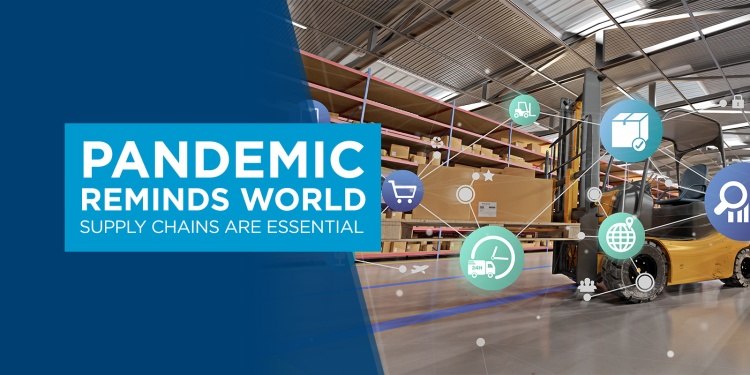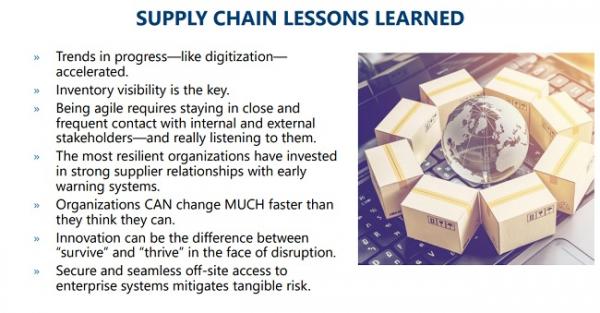
The global pandemic exposed both the vulnerability and the importance of supply chains to business and the daily lives of consumers. With shortages from flour to shipping containers and toilet paper to freezers, consumers discovered what business has known all along: supply chains are essential.
Or, as I like to say, “Supply chain is sexy again.”
Supply chain is in the process of being reinvented. 2020 shattered some supply chain paradigms i.e., single-source supplier relationships, offshoring, running lean, and just in time inventory. Some of the changes are new, and some are trends accelerated by the pandemic.
- Despite shortages, the pandemic accelerated the business-to-business (B2B) trend toward stiff requirements for fast delivery and real-time tracking of shipments. Consumer expectations of speed, transparency and visibility are spilling over into B2B.
- There is a stronger movement to onshoring and movingaway from single source suppliers to having multiple suppliers in multiple geographies for global products.
- There is more focus on traceability of shipments and transparency so customers can know where the product is coming from and can track the source of lost or contaminated product.
- Shipping costs have risen dramatically—as have materials and commodities required for pandemic-related sanitation, protection and vaccination. Demand for dry ice to protect the COVID-19 vaccine in shipment is up 1100 percent.
Buying online, then picking up in-store or curbside; returning online purchases to stores all challenged every step of the supply chain. The good news is that many organizations discovered they can change their supply chains much faster than they thought they could. APQC’s supply chain research practice tracked numerous “pivots” and found it is possible to innovate more and spend less. (Read the white paper here: 2020 Supply Chain Challenges and Priorities).
Recently, I spoke with supply chain expert George Bailey about customer requirements emerging from the pandemic; why traditional change management approaches can’t transform supply chains to meet the needs of this new customer; and an alternative approach for making change happen more quickly in supply chain and business.
(Read the full transcript here: Reinventing Supply Chain: An Interview with DSCI’s George Bailey).
George Bailey is a Fellow in the Center for Global Enterprise (CGE) the not-for-profit that houses the Digital Supply Chain Institute (DSCI). He is on the Advisory Board of Lockheed Martin, the APQC Board of Directors and is the Executive Professor of Digital Innovation and Management at Pepperdine University. Previously, George ran the semiconductor business at IBM. And for four years he consulted with the chairman of Sony on models for rapid change. So George knows a bit about supply chains and change.
I asked George how COVID has disrupted the classic paradigms of supply chain. He said requirements for speed, transparency and traceability have grown. He gave as an example Dell and Colgate-Palmolive. These organizations invested in automation and instead of a single supplier, they've changed their supply base so they don't have one country as the center for manufacturing. “And as a result, they had disruptions of course, but they really keep their product flowing and keep things in the marketplace,” Said George.
Emerging Customer Requirements
George also shared findings from a recent DSCI Survey of 1,300 companies from five countries. In B2B, “customers are saying that they want more rapid delivery and not just a little bit. There's about 30% that say they would like to have delivery within 24 hours. And there's another 30% that want delivery within two days. If that’s what the customer wants, you have to rethink everything: where you make things, where your suppliers are located.”
George went on to explain: “In our global survey of B-to-B customers, we asked them about what was driving their decisions. And it turns out that a big driver of change is your experience as consumers. So, when consumers buy things on Amazon, they're like, oh, yeah, I got this in two days. Why am I spending all this money on this, and I'm getting it in two months? Ridiculous.” In addition, “now it's quite evident that people want to be able to have access to how other buyers have experienced that product. The Amazon example: When you go to Amazon, you see how other people have evaluated their product and you make a decision based on that.”
Change Management Has Changed
George and I also discussed the disruption of classic models of change management. Using the multiplayer game called Fortnite as a metaphor, George identified three requirements for transitioning to a more agile supply chain:
1) rotating leadership based on who has the best skills and knowledge for the issue or process at hand (instead of a command-and-control model);
2) real-time data access to understand the needs of the situation; and
3) leaders letting go and trusting team members based on knowledge of their capabilities.
“When you're playing, you can see all the other players and you can look at them and decide based on the data because you can pull it up, what their history has been, what they're good at and how to handle them,” said George.
Even as we invent the new tomorrow in our supply chains, it behooves us to remember the fundamentals that still matter: strong collaborative supplier relationships; scenario planning; intelligent automation; and developing and valuing people and communities. For more about how resilient supply chains thrive in uncertainty, see: 2021 Supply Chain Challenges and Priorities: Survey Report and Blockchain and RPA Leading Supply Chain Trends in 2021.
